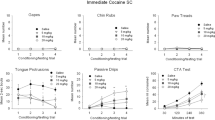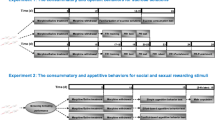Abstract
Conditioned withdrawal among golden Syrian hamsters was studied in two experiments. In experiment 1, morphine-pelleted (75 mg) hamsters were observed for signs of withdrawal (wet-dog shakes, etc.) before and after a naloxone (1 mg/kg) injection that was administered in a distinctive environment. Withdrawal signs that occurred in the distinctive environment before the naloxone injection were defined as anticipatory conditioned withdrawal responses. Two, 9, and 30 days following pellet removal, retention of conditioned withdrawal responding was assessed in the distinctive environment before and after a saline injection. Results indicated that: a) withdrawal intensity was a direct function of the number of implanted pellets; b) conditioned withdrawal occurred among animals withdrawn in the distinctive environment, but not among those withdrawn in the home cage; c) conditioned withdrawal was a non-monotonic function of precipitated withdrawal intensity; d) conditioned withdrawal was evident up to 30 days after pellet removal. In experiment 2, conditioned withdrawal was extinguished by repeated exposure to the distinctive environment in the absence of precipitated withdrawal. It was concluded that environmental stimuli associated with theabsence of morphine (i.e., precipitated withdrawal) elicit conditioned withdrawal. The results are compared to similar findings in rats and humans.
Similar content being viewed by others
References
Baker TB, Tiffany ST (1985) Morphine tolerance as habituation. Psychol Rev 92:78–108
Baker TB, Morse E, Sherman JE (1986) The motivation to use drugs: a psychobiological analysis of urges. In: Rivers C (ed) Nebraska symposium on motivation. University of California Press, Berkeley, CA, pp 257–323
Blasig J, Herz A, Reinhold K, Zieglgansberger S (1973) Development of physical dependence on morphine in respect to time and dosage and quantification of the precipitated withdrawal syndrome in rats. Psychopharmacologia 33:19–38
Bozarth MA, Wise RA (1984) Anatomically distinct opiate receptor fields mediate reward and physical dependence. Science 224:516–517
Childress AR, McLellan AT, Ehrman R, O'Brien CP (1988) Classically conditioned responses in opioid and cocaine dependence: a role in relapse? In: Ray BA (ed) Learning factors in substance abuse. NIDA research monograph no. 84, United States Government Printing Office, Washington DC, pp 25–43
Cicero TJ, Meyer ER (1973) Morphine pellet implantation in rats: quantitative assessment of tolerance and dependence. J Pharmacol Exp Ther 184:404–408
Collins KH, Tatum AL (1925) A conditioned reflex established by chronic morphine poisoning. Am J Physiol 74:14–15
Davis WM, Smith SG (1976) Role of conditioned reinforcers in the initiation, maintenance and extinction of drug seeking behavior. Pavlov J Bio Sci 11:222–236
Goldberg SR, Schuster CR (1967) Conditioned suppression by a stimulus associated with nalorphine in morphine-dependent monkeys. J Exp Anal Behav 10:235–242
Goldberg SR, Schuster CR (1970) Conditioned nalorphine-induced abstinence changes: persistence in post morphine-dependent monkeys. J Exp Anal Behav 14:33–46
Goode PG (1971) An implanted reservoir of morphine solution for rapid induction of physical dependence in rats. Br J Pharmacol 41:558–566
Goudie AJ, Demellweek C (1986) Conditioning factors in drug tolerance. In: Goldberg SR, Stolerman IP (eds) Behavioral analysis of drug dependence. Academic Press, New York, pp 225–286
Grabowski J, O'Brien CP (1981) Conditioning factors in opiate use. In: Mello NK (ed) Advances in substance abuse, vol 2. JAI Press, Greenwich, CT, pp 69–121
Huffman RD, Simmons KE, Lum JT (1985) An intraventricular infusion model for inducing morphine dependence in rats: quantitative assessment of precipitated withdrawal. Behav Neurosci 99:861–880
Kalivas PW, Duffy P (1988) Effects of daily cocaine and morphine treatment on somatodendritic and terminal field dopamine release. J Neurochem 50:1498–1504
Koga Y, Inukai T (1981) Assessment of physical dependence-inducing capacity of narcotic agonists and antagonists in rats by intermittent infusion technique. Psychopharmacology 73:236–239
Koob GF, Wall TL, Bloom FE (1989) Nucleus accumbens as a substrate for the aversive stimulus effects of opiate withdrawal. Psychopharmacology 98:530–534
Lindesmith A (1968) Addiction and opiates, 2nd edn. Aldine, Chicago
Mackintosh NJ (1974) The psychology of animal learning. Academic Press, New York
Martin WR, Wikler A, Eades CG, Pescor FT (1963) Tolerance to and physical dependence on morphine in rats. Psychopharmacologia 4:247–260
Meyer RE, Mirin SM (1979) The heroin stimulus. Plenum Press, New York
O'Brien CP (1975) Experimental analysis of conditioning factors in human narcotic addiction. Pharmacol Rev 27:535–543
O'Brien CP, Testa T, O'Brien TJ, Greenstein R (1976) Conditioning in human opiate addicts. Pavlov J Biol Sci 11:195–202
O'Brien CP, Testa T, O'Brien TJ, Brady JP, Wells B (1977) Conditioned narcotic withdrawal in humans. Science 195:1000–1002
O'Brien CP, Ehrman RN, Ternes JW (1986) Classical conditioning in human opioid dependence. In: Goldberg SR, Stolerman IP (eds) Behavioral analysis of drug dependence. Academic Press, New York, pp 329–356
Pavlov IP (1927) Conditioned reflexes. Oxford University Press, Oxford, England
Rozin P, Kalat JW (1971) Specific hungers and poison avoidance as adaptive specializations of learning. Psychol Rev 78:459–486
Schnur P (1991) Acute morphine dependence in the hamster. Pharmacol Biochem Behav 38:711–713
Schnur P, Martinez RA (1989) Environmental control of morphine tolerance in the hamster. Anim Learn Behav 17:322–327
Seligman MEP (1970) On the generality of laws of learning. Psychol Rev 77:406–418
Sherman SI, Zinser MC, Sideroff SI, Baker TB (1989) Subjective dimensions of heroin urges: Influence of heroin-related and affectively negative stimuli. Addict Behav 14:611–623
Sideroff SI, Jarvick ME (1980) Conditioned responses to a videotape showing heroin related stimuli. Int J Addict 15:529–536
Siegel S (1976) Morphine analgesic tolerance: its situation specificity supports a Pavlovian conditioning model. Science 193:323–325
Siegel S (1977) Morphine tolerance acquisition as an associative process. J Exp Psychol [Anim Behav Proc] 3:1–13
Siegel S (1983) Classical conditioning, drug tolerance and dependence. in: Smart RG, Glaser FB, Israel Y, Kalant H, Popham RE, Schmidt (eds) Research advances in alcohol and drug problems. Plenum Press, New York, pp 207–246
Stewart J, Eikelboom R (1987) Conditioned drug effects. In: Iverson LL, Iverson SD, Snyder SH (eds) Handbook of psychopharmacology: new directions in behavioral pharmacology, vol 19: Behavioral pharmacology. Plenum Press, New York, pp 1–57
Stewart J, de Wit H, Eikelboom R (1984) Role of unconditioned and conditioned drug effects in the self administration of opiates and stimulants. Psychol Rev 91:251–268
Teasdale J (1973) Conditioned abstinence in narcotic addicts. Int J Addict 8:273–292
Thompson T, Ostlund W (1965) Susceptibility to readdiction as a function of the addiction and withdrawal environments. J Comp Physiol Psychol 60:388–392
Tilson HA, Rech RH, Stolman S (1973) Hyperalgesia during withdrawal as a means of measuring the degree of dependence in morphine dependent rats. Psychopharmacologia 28:287–300
Wikler A (1948) Recent progress in research on the neurophysiological basis of morphine addiction. Am J Psychiatry 105:328–338
Wikler A (1965) Conditioning factors in opiate addiction and relapse. In: Wilner DM, Kassebaum GG (eds) Narcotics. McGraw-Hill, New York, pp 85–100
Wikler A (1973) Conditioning of successive adaptive responses to the initial effects of drugs. Conditional Reflex 8:193–210
Wikler A, Pescor FT (1967) Classical conditioning of a morphine abstinence phenomenon, reinforcement of opioid drinking behavior and “relapse” in morphine addicted rats. Psychopharmacologia 10:255–284
Wikler A, Pescor FT, Miller D, Norrell H (1971) Persistent potency of a secondary (conditioned) reinforcer following withdrawal of morphine from physically dependent rats. Psychopharmacologia 20:103–117
Wise RA, Bozarth MA (1987) A psychomotor stimulant theory of addiction. Psychol Rev 94:469–492
Author information
Authors and Affiliations
Rights and permissions
About this article
Cite this article
Schnur, P. Conditioned morphine withdrawal in the hamster. Psychopharmacology 107, 517–522 (1992). https://doi.org/10.1007/BF02245265
Received:
Revised:
Issue Date:
DOI: https://doi.org/10.1007/BF02245265




